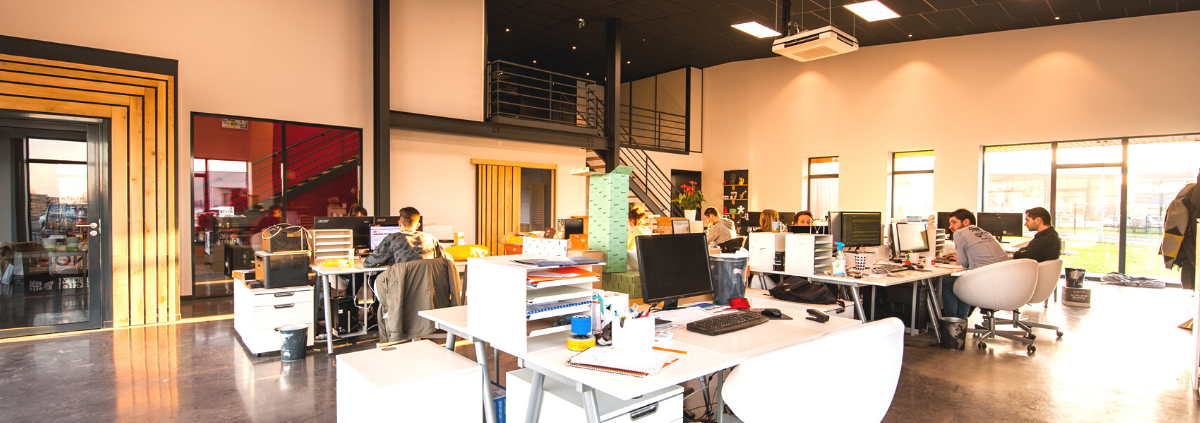 Canva Pro
Canva ProEnergy Efficient Office Toolkit
Office buildings can consume energy in a wide variety of areas, including lighting, heating and cooling, and equipment use, such as computers and printers. Taking measures to improve the efficiency of each area can greatly reduce energy costs and create a more productive, comfortable work space. Many of the changes that can be made in an office are relatively low cost or have a quick simple payback. Below are some areas you should consider to improve office energy efficiency.
Lighting
Lighting is often one of the highest energy users in an office building, accounting for 15%-40% of the annual energy use of the building. Upgrading to LED lights is one of the easiest and most cost-effective ways to cut back on energy use and save money. Therefore, always consider lighting first in any review of potential energy-saving projects. Not only do upgraded lighting fixtures produce light more efficiently, they also operate at a lower temperature, reducing the need for additional cooling of the building.
However, energy and cost savings aren’t the only benefits of an upgraded lighting system. Additional benefits include:
- Increased productivity: better lighting may contribute to increased productivity through faster work patterns with fewer errors.
- Reduced absenteeism: improper lighting can cause glare which results in fatigue, headaches, and absenteeism.
- Increased safety and security: proper lighting levels reduce the possibility of burglary and also improve safety of employees.
- Lower maintenance costs: some light sources have longer lamp life, which could result in lower lamp replacement and labor costs.
In addition to upgrading to new LED fixtures, lighting controls can be installed to further increase energy efficiency. Lighting controls automatically adjust lighting levels when rooms are unoccupied, when natural daylight is supplying sufficient lighting, or when only partial light is needed, thereby saving energy.
For more information on lighting, check out our Energy Efficient Lighting Toolkit.
Lighting Control Options and Tips
- Daylight sensors/dimmers: Operated through use of photo cells, daylight sensors and dimmers can control lighting in both interior and exterior office lights, depending on the amount of available daylight in the space. Settings can be adjusted so that lights automatically increase or decrease when natural lighting levels fall below or above certain thresholds.
- Occupancy sensors: These can come in a variety of options to detect occupancy by movement, heat, or a combination of the two. Settings can be adjusted so lights shut off at various times when no occupancy is detected. Occupancy sensors are great for bathrooms, break rooms, or other areas that see frequent, but brief, visitors.
- Task lighting: This is a direct lighting source such as a desk lamp, which can be turned on when more light is needed in a specific area, as opposed to increasing lights for the whole room.
Computers and Other Appliances
Computers and other office equipment are big energy consumers in an office space. Similar controls can be implemented to ensure that these appliances aren’t consuming energy when they don’t need to be.
Computer Control Options
- Set computers and other equipment to fall into “sleep mode” after a set time of inactivity.
- Ensure that computers, printers, and kitchen appliances, like coffee makers and refrigerators, are ENERGY STAR-certified. While ENERGY STAR appliances are often more expensive initially, the money saved through reduced energy costs often more than make up the difference.
- Install power strips for conference rooms and offices that have many related appliances plugged in to the wall. This makes it easier to turn on and off the entire system, as well as reduces the ghost load being drawn from the wall.
- Utilize electronic documents where possible to reduce unnecessary printing.
The HVAC System
 The heating, ventilation, and air conditioning (HVAC) system is the last big energy consumer in an office building. Maintaining comfortable working temperatures is essential for productivity in the workplace, and ensuring that the system is energy-efficient is essential for maintaining a reasonable energy bill.
The heating, ventilation, and air conditioning (HVAC) system is the last big energy consumer in an office building. Maintaining comfortable working temperatures is essential for productivity in the workplace, and ensuring that the system is energy-efficient is essential for maintaining a reasonable energy bill.
Office buildings usually include both peripheral and interior zone spaces. The peripheral zones frequently have large window areas and may be considerably subdivided. These zones often have variable loads because of changing weather and sun position and typically require heating in winter. During spring and fall seasons, one side of the building may require cooling, while another side requires heating.
The interior zone spaces usually require a fairly uniform cooling rate throughout the year because their thermal loads are derived almost entirely from people, lights, computers, and other office equipment. As the cooling loads can vary from full to low- or no-load conditions, interior systems may utilize variable air volume (VAV) controls.
For specific information on improving the efficiency of your HVAC system, take a look at the HVAC System and HVAC Controls Toolkits. Some quick tips to ensure your HVAC system is running efficiently include:
- Clean and replace filters according to manufacturer’s directions to ensure that the HVAC system isn’t working harder than necessary.
- Use programmable thermostats to automatically raise and lower temperatures according to building occupancy times.
- Ensure vents are free from obstruction so that air can circulate properly.
- Repair leaks and install insulation around duct and pipe lines.
- Schedule regular maintenance on your HVAC equipment to ensure its operating efficiently.

